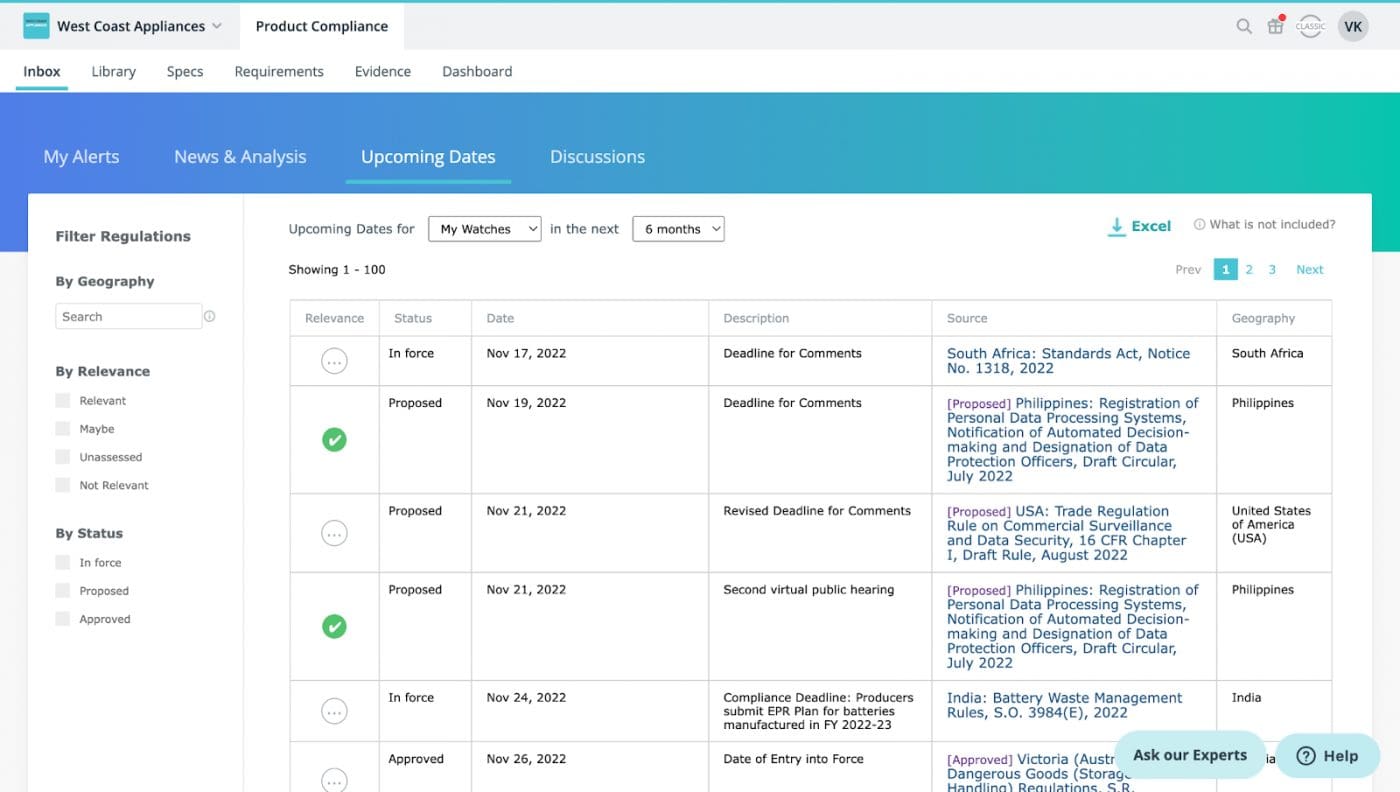
The Ultimate Guide to Buying Product Compliance Software

Table of Contents
- Digitizing Product Compliance
- Assessing Your Compliance Requirements
- Must Haves for Compliance Software Selection
- Challenges to Making the Right Decision
- Product Compliance Solution, Powered by C2P
Digitizing Product Compliance
93% of compliance risk study respondents surveyed by Accenture agreed that leveraging new technologies like artificial intelligence and cloud computing can simplify compliance processes. These technologies automate repetitive tasks, reduce errors, and enhance the overall effectiveness and efficiency of compliance processes.
In the same study, Accenture discovered that 90% of compliance leaders anticipated a substantial 30% increase in compliance costs in the near future. Surprisingly, despite this projection, 72% of these leaders did not foresee any changes in their allocated budget over the next few years.
Selecting the appropriate product compliance software is critical for achieving your compliance team’s success. However, the process of purchasing such software can be overwhelming and intricate. In this comprehensive guide, we will provide you with essential considerations and step-by-step instructions to help you make an informed decision.
Assessing Your Compliance Requirements
Before embarking on the software selection process, it is crucial to evaluate your team’s specific compliance requirements. Consider the following factors:
- Industry-Specific Compliance
Different industries have unique compliance regulations and standards. Identify the specific regulatory areas pertinent to your industry, such as environmental, health, safety, or product-specific compliance.
- Geographical Scope
Determine whether your compliance obligations are local, national, or international. Some software solutions specialize in specific regions or offer comprehensive global coverage.
- Compliance Lifecycle
Evaluate your team’s compliance processes, from product development to testing, documentation, certification, and ongoing monitoring. Identify pain points and areas where software automation can yield the most significant benefits.
Must Haves for Compliance Software Selection
When assessing product compliance software options, it is essential to consider the following key factors to ensure a well-aligned choice:
1. Regulatory Database & Updates
It is crucial to opt for a solution that offers an extensive and up-to-date regulatory database. This database should provide real-time updates to keep your team in compliance with the latest regulations and standards relevant to your industry and geographical scope.
Benefits:
- Your team stays informed and aligned with the ever-changing compliance landscape.
- Reduced risk of non-compliance and potential penalties.
2. Compliance Monitoring & Auditing
Regulatory monitoring capabilities play a critical role in tracking compliance status, identifying potential issues, and scheduling audits. To facilitate proactive compliance management, the software should provide customizable dashboards, alerts, and reporting features.
Benefits:
- Stay on top of compliance requirements.
- Address any issues promptly – Ensure regulatory adherence.
- Streamline your compliance processes.
- Maintain a proactive approach to compliance management.
3. Document Management
Efficient document management is paramount for maintaining compliance and so it is essential to prioritize solutions that offer robust document management capabilities. Look for software that provides centralized document storage, version control, automated workflows, and secure access controls.
Benefits:
- Easily retrieve, collaborate, and maintain compliance-related documents.
- Ensure the integrity and accessibility of critical compliance documentation.
- Enhance the compliance team’s efficiency and simplify your compliance processes.
4. Risk Assessment & Mitigation
Look for software that offers robust tools for identifying potential compliance gaps, conducting thorough risk assessments, and implementing strategies to mitigate risks. These features are essential for maintaining regulatory compliance and minimizing the potential impact of compliance-related risks on your business.
Benefits:
- Proactively address compliance challenges.
- Ensure a strong foundation of regulatory adherence.
- Effectively assess and mitigate risks.
5. Audit Trail & Reporting
Audit trail and robust reporting capabilities play a crucial role in demonstrating regulatory compliance during audits and inspections. An audit trail feature allows you to record and track compliance activities and changes within the software.
Customizable compliance reports, analytics, and data visualization tools enable you to generate comprehensive reports tailored to your specific compliance requirements. With customizable reports, you can present compliance data in a clear and concise manner, facilitating better decision-making and demonstrating your adherence to regulations and standards.
Benefits:
- Maintain transparency.
- Comprehensive historical view of compliance-related actions.
- Easily trace and verify compliance activities.
- Ensure accountability and integrity in your compliance management processes.
- Facilitate better decision-making.
- Demonstrate compliance with regulations and standards.
Furthermore, the software’s analytics and data visualization capabilities allow you to gain insights from compliance data, identify trends, and make data-driven decisions. These features empower you to proactively address compliance issues and optimize your compliance processes for better efficiency and effectiveness.
Challenges to Making the Right Decision
Here are some key challenges to be aware of:
1. Identifying Relevant Features
- Product compliance software comes with a wide range of features and functionalities. However, not all features may be relevant to your team’s specific needs. It is important to identify the key features that align with your compliance requirements and prioritize them during the selection process. This requires a deep understanding of your compliance processes and pain points.
2. Ensuring Compatibility & Integration
- The chosen software should seamlessly integrate with your team’s existing tools and technologies to ensure a smooth transition and efficient workflow. Compatibility issues can lead to disruptions and inefficiencies in compliance management.
3. Evaluating Vendor Credibility & Support
- Selecting a reliable and reputable vendor is crucial for the successful implementation of product compliance software. Conduct thorough research on potential vendors, their track records, customer reviews, and customer support services. Ensuring that the vendor is committed to providing ongoing support and updates is essential for a long-term partnership.
4. Balancing Cost & Value
- It is important to strike a balance between cost and the value provided by the product compliance software. Cheaper options may lack critical features or robust support, while more expensive solutions may exceed your team’s requirements. Consider the long-term benefits and return on investment when evaluating the cost.
5. User-Friendliness & Training
- Product compliance software should be user-friendly and intuitive to ensure easy adoption by your team. Complex interfaces or steep learning curves can hinder productivity and adoption rates. Additionally, consider the availability of training and resources provided by the vendor to support your team in effectively using the software.
6. Scalability & Future-Proofing
- As your business grows and compliance requirements evolve, scalability becomes crucial. Ensure that the software can accommodate future needs and adapt to changing compliance regulations. Choosing a scalable solution will save you from the hassle and cost of switching to new software as your compliance needs expand.
Navigating these challenges requires a strategic approach, thorough evaluation, and effective communication within your team. By addressing these challenges proactively, you can make an informed decision and select the best product compliance software that meets your team’s needs, streamlines compliance processes, and ensures regulatory adherence.
Building a Business Case
The true cost of outdated compliance processes is more than just fines and penalties. To build a compelling business case, start by clearly understanding the challenges and pain points your organization currently faces in managing product compliance.
Consider factors such as regulatory complexity, manual processes, resource limitations, risk exposure, and the potential consequences of non-compliance. Quantify the impact of these challenges in terms of costs, productivity, and reputational risk relevant to your business.
Here’s a how-to guide, where we discuss the essential steps and considerations for creating a robust business case for a product compliance SaaS solution, enabling you to move forward confidently.
Product Compliance Solution, Powered By C2P
Compliance & Risks has developed an innovative technology platform, called C2P, that helps the world’s leading brands comply with global regulatory changes. C2P helps compliance teams accelerate their ability to achieve, maintain and expand market access for all their products in international markets.
C2P is purpose-built to be tailored to a company’s specific needs with comprehensive capabilities that enable enterprise-wide management of regulations, standards, requirements and evidence. Add-on packages help accelerate market access through use-case-specific solutions, global regulatory content, a global team of subject matter experts, and professional services.
See Figure 1 below, a screenshot from C2P Product Compliance Solution, showcasing the timeline of upcoming regulatory changes.

Figure 1: Timeline of upcoming regulatory changes (Source: C2P Product Compliance Solution)
There are 5 key areas that C2P Product Compliance Solution helps companies with:
- Identify relevant regulations and standards
- Interpret the regulations and standards for your products
- Communicate the regulatory requirements to the teams who need to implement them
- Determine the evidence needed to prove compliance against each of these requirements
- Monitor changing regulations and standards globally to ensure compliance at all times
C2P serves as a single source of compliance information for the teams and helps in driving a ‘Zero surprises’ compliance policy for the business. (See Figure 2 below, a screenshot from C2P, with live linking between regulations, standards, requirements and evidence).

Figure 2: Product compliance management system (Source: C2P Product Compliance Solution)
To learn more about how C2P can help with your product compliance requirements, talk to us today.
Selecting the right product compliance management software is a critical decision for organizations seeking to streamline compliance processes and mitigate risks. Remember, it is recommended to evaluate multiple software vendors, request demos, and involve relevant stakeholders in the decision-making process to select a solution that best meets your organization’s compliance needs.
Authors



